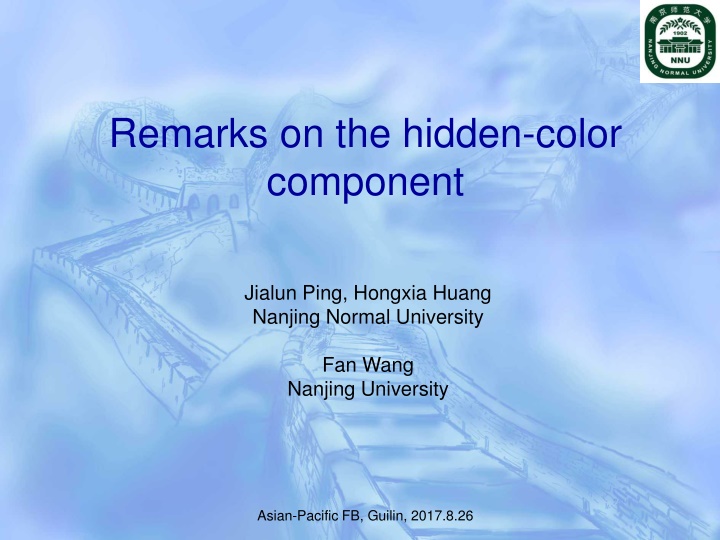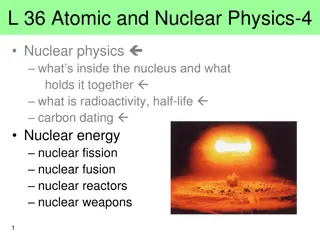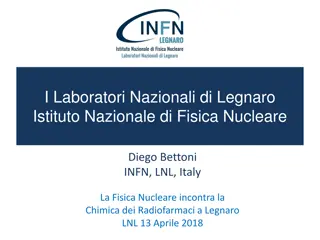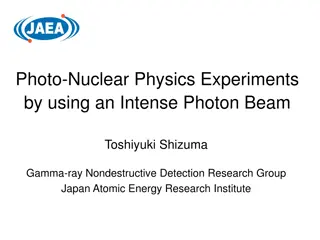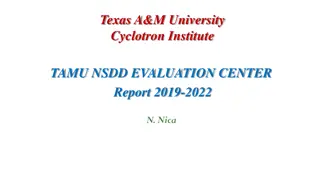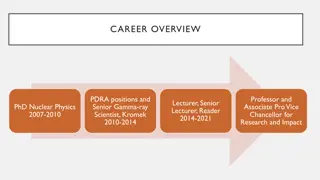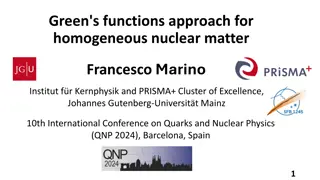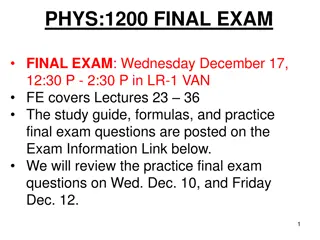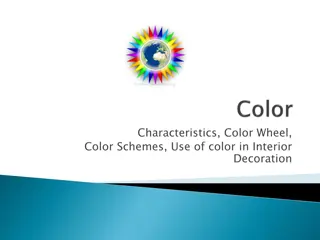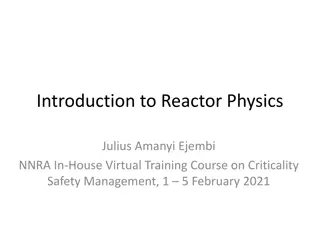Insights on the Hidden Color Component in Nuclear Physics
Introduction to the hidden color component in nuclear physics, discussing its definition, physical effects, and multiquark states like tetraquarks, pentaquarks, and dibaryons. Various models and ongoing debates on the role of hidden colors in multi-quark systems are explored. The concept of colorless nucleons and the introduction of hidden color components open up new dimensions in understanding the dynamics of quark systems.
Download Presentation

Please find below an Image/Link to download the presentation.
The content on the website is provided AS IS for your information and personal use only. It may not be sold, licensed, or shared on other websites without obtaining consent from the author.If you encounter any issues during the download, it is possible that the publisher has removed the file from their server.
You are allowed to download the files provided on this website for personal or commercial use, subject to the condition that they are used lawfully. All files are the property of their respective owners.
The content on the website is provided AS IS for your information and personal use only. It may not be sold, licensed, or shared on other websites without obtaining consent from the author.
E N D
Presentation Transcript
Remarks on the hidden-color component Jialun Ping, Hongxia Huang Nanjing Normal University Fan Wang Nanjing University Asian-Pacific FB, Guilin, 2017.8.26
Outline I. Introduction II. Physics bases and symmetry bases III. Physical effects of hidden-color component IV. Summary Asian-Pacific FB, Guilin, 2017.8,26
I. Introduction What is the hidden-color component? To deal with the dynamics of multi quark systems, quark cluster model simplifies the many body problem into a two body one via fixing the internal structure of cluster. Typical example: using two nucleon cluster to deal with NN interaction from quark-gluon degree of freedom. Nuclear physics shows this is a god approximation. In nuclear physics we only have colorless nucleon, for QCD based nuclear physics we have the new degree of freedom: hidden color component. Clusters A and B are colorless, A+B colorless, color singlet component Clusters A and B are colorful, A+B colorless, hidden-color component Asian-Pacific FB, Guilin, 2017.8,26
I. Introduction What is the hidden-color component? quark cluster model multi-quark systems many body problem a two body one internal structure of cluster is fixed Typical example: NN interaction from quark-gluon d.o.f. Nuclear physics: a good approximation. Asian-Pacific FB, Guilin, 2017.8,26
Definition In conventional nuclear physics: only colorless nucleon, QCD based nuclear physics: new d.o.f: hidden color component. Clusters A and B are colorless, A+B colorless, color singlet component Clusters A and B are colorful, A+B colorless, hidden-color component 9th Workshop on hadron physics in China and opportunities worldwide, Nanjing, 2017.7,26
Multiquark states Tetraquark: Zc(3900), Zb(10610) (BES Belle 2013) Pentaquark: Pc(4380), Pc(4450) (LHCb 2015) Dibaryon: d* (IJP=03+), (WASA-at-COSY 2009-2014) N ? (STAR@RHIC 2017) PRL 102, 052301 (2009); M=2.36 GeV, =80 MeV PRL 106, 242302 (2011); M=2.37 GeV, =70 MeV IJP=03+ PLB 721, 229 (2013); M=2.37 GeV, =70 MeV PRC 88, 055208 (2013); M=2.37 GeV, =70 MeV PRL 112, 202301 (2014); M=2.380 0.010 GeV, =40 5 MeV Asian-Pacific FB, Guilin, 2017.8,26
Multiquark structure Many models proposed: hadronic molecules compact multiquark states hybrid hidden-color No consensus yet There are misunderstandings on the physical effects of the hidden-color components for the multi-quark systems. Asian-Pacific FB, Guilin, 2017.8.26
II. Physical bases and symmetry bases Two kind bases of many body systems: symmetric and physical bases both were developed in nuclear physics respectively in nuclear shell model and cluster model. An example of nuclear model : Elliott model with group chain (??4 ? ??? Symmetry basis: ?? ??2 ? ??2 ?) (??3 ??3) ??? ? ??? ? ???????? Physical basis: ??? ?????(?) ? ??1?1?1??2?2?2 ??? ??? Asian-Pacific, Guilin, 2017.8,26
Generalized to quark model M. Harvey: NPA352(1981)301, J.Q. Chen: NPA393(1983)122, F. Wang, J. L. Ping, T. Goldman: PRC51(1995)1648 xcf x cf c f SU (36) SU (2) SU (18) SU SU SU (3) (2) SU U (6) f s ( (3) (1)) SU (2) Physical basis: Symmetry basis: Asian-Pacific FB, Guilin, 2017.8,26
Unitary transformation? The transformation is restricted within the same configuration. The transformation is unitary only if two sets of bases are both orthonormal ones. Are symmetry bases and physical bases orthonormal in the two-center case? Yes, if the single particle states are orthonormal (s ) ? ? = ? ? = 1, ? ? = 0 However the usual two-center single-particle orbital states for cluster mode 2/2?2 2/2?2 3/4 3/4 ? ?+? ? ? ? 1 1 ? = ? = 2 2 ??2 are not orthogonal, m = ? ? 0 ??2 Asian-pacific FB, Guilin, 2017.8.26
Harveys method Introducing separation dependent normalization factor ? 6 ,? = ? 42 ,? = ? 51 ,? = ? 33 ,? = Such defined symmetry bases are orthonormal and the physical bases via transformation obtained are orthonormal too. 1 + 9?2+ 9?4+ ?6 1 ?2 ?4+ ?6 1 + 3?2 3?4 ?6 1 3?2+ 3?4 ?6 transformation table is unitary Problems: 1. Physical bases only can be obtained through the unitary transformation, can not be defined independently. 2. Having physical meaning only for the infinite separation of two cluster centers. 3. Center of mass motion can not be separated. Asian-Pacific FB, Guilin, 2017.8.26
Transformation (cont) In quark cluster model calculation one uses this relation for independent defined physical (cluster) bases, valid for non-orthogonal single particle orbital states center of mass motion can be separated from the internal motion Note: the physical bases are not orthonomal in general. Asian-Pacific FB, Guilin, 2017.8.26
III. Physical effects of hidden color component Is NN repulsive core due to hidden color component? S. Brodsky et al., PRL51(1983)83, C.R. Ji, J.Phys.Conf.Ser. 543(2014)No.1,012004 No! Deuteron and d* have the same amount hidden-color component at short distance, but d* has strong short range attraction instead of repulsive core. It is due to CMI of one-gluon-exchange! Asian-Pacific FB, Guilin, 2017.8,26
Is the NN Intermediate-range attraction due to color van der Waals force HC? Just partly! Not the dominant one! S.Brodsky, PR64(1990)1011, PLB412(19970125 N-N interaction is a QCD duplication of QED H-H molecular interaction. H atoms: electric neutral, electric charge and orbital distortion molecular force (electron percolation) Nucleons: color neutral, color charge and orbital distortion nuclear force (quark delocalization) We developed a molecular bond analog model for NN interaction, QDCSM, which describe the deuteron and NN scattering quantitatively well. PRL69(1992)2901 Asian-Pacific FB, Guilin, 2017.8,26
Similarity between nuclear force and molecular force A.Bohr and B. Motelson, Nuclear structure 1975 spin singlet spin triplet isospin singlet interaction between atoms interaction in deuteron Asian-Pacific FB Guilin 2017.8,26
CPEP statement in Standard model chart The strong binding of color-neutral protons and neutrons to form a nuclei is due to residue strong interactions between their color charged constituents. It is similar to the residual electrical interaction that binds electrical neutral atoms to form molecules. Asian-Pacific Guilin, 2017.8,26
QDCSM Color screening qq interaction: inside baryon usual confinement outside baryon color screening confinement The HC coupling is taken into account via this color screening confinement and has been checked through a quantitative color singlet-HC channel coupling calculation. PRC84(2011)064001 Asian-Pacific FB, Guilin, 2017.8.26
Delocalized two center quark orbit = + ( ) s ( )( N s l r , l = + S) ( )( N s r l ), r N(s) normalization constant, delocalization parameter, it is not an adjusted parameter, but determined by the dynamics of the multi-quark system ! ( ) s Asian-Pacific FB, Guilin, 2017.8,26
delocalization parameter ( ) s Asian-Pacific FB Guilin. 20178.26
deuteron Asian-Pacific FB Guilin 2017.8.26
Narrow width of d* Bashkanov-Brodsky-Clement: PLB 727(2013)438 Asian-Pacific FB, Guilin, 2017.8,26
Huang-Zhang-Shen-Wang: arXiv:1408.0458 CC channel: 66%--68% 70 MeV Huang-Ping-Wang: PRC89(2014)034001 B.Juan-Diaz,T.S.H. Lee, A.Matsuyama, T.Sato: PRC76(2007)065201 Asian-Pacific FB, Guilin, 2017.8,26
Our Feshbach resonance calculation obtained the right resonance scattering partial width (14 Mev versus 12 MeV), it is consistent with the WASA-at- COSY measurement: the d* is formed from formation. Our rough estimate of the decay width is much larger than the measurement one ( 110 MeV versus 70 MeV ) means after formation it shrinks into a compact six-quark state due to strong attraction between two (with a rms~1.2 fm.) r N N di bound di Asian-Pacific FB, Guilin, 2017.7,26
Hidden-color component or compact six-quark state d* compact object ----- taking limit: six quarks in one bag Asian-Pacific FB, Guilin, 2017.8,26
Cluster model is an approximation used to describe the multi quark system. It is good for a system like deuteron or hadron scattering. If the system is a compact multi-quark one, the cluster approximation is no longer useful. Still to talk about color singlet di-hadron and hidden- color component is meaningless. In fact, as the two clusters close together, the overlap of colorless and hidden color components become bigger and bigger and finally collapse into the same one. Asian-Pacific FB, Guilin, 2017.8,26
6 quarks are in the same orbit: []=[6] remains, [42] disappears Symmetry basis: only [6][33][33] exists ------> number of physical basis: 1 and CC are the same ! < | CC > =1 Asian-Pacific FB, Guilin, 2017.8,26
numerical results Calculation method: RGM+GCM Asian-Pacific FB, Guilin, 2017.8,26
+S/2, -S/2: the reference centers of baryons S 0, [6] exists, [42] disappears < | CC > =1 Continuity < | CC > approx. 1, when S is small. S (fm) < | CC > S (fm) < | CC > 3 0 0.3 0.997 2 7x10-3 1 0.7 0.1 0.99996 0.5 0.98 0.001 ~ 1 0.4 0.99 0.2 0.999 Asian-Pacific FB, Guilin, 2017.7,26
Matrix elements: S (fm) < |H| > < CC |H|CC > < |H| CC > 3 2580 7770 ~0 2 2571 4870 9.9 1 2451 2679 1616 0.5 2649 2714 2609 0.3 2739 2763 2741 0.2 2771 2782 2774 0.1 2791 2794 2792 Asian-Pacific FB, Guilin, 2017.8,26
d* in chiral quark model (two channels: and CC) S(fm) 0.1 0.2 0.3 0.4 0.5 E(MeV) 2404.0 2404.0 2404.1 2404.1 2405.0 (%) 50 50.2 40.8 85.2 94.2 CC(%) 50 49.8 59.2 14.8 5.8 Physical basis and symmetry basis: same results Asian-Pacific FB, Guilin, 2017.8,26
Using Harveys method S(fm) 0.1 0.3 0.5 0.7 0.9 E(MeV) 2745.7 2706.4 2635.0 2546.0 2463.5 (%) 46 46 50 54 60 CC(%) 54 54 50 46 40 S(fm) 1.1 1.3 1.5 1.7 1.9 E(MeV) 2423.6 2454.0 2513.7 2550.6 2567.1 (%) 71 87 97 100 100 CC(%) 29 13 3 0 0 CC is not dominant Asian-Pacific FB, Guilin, 2017.8,26
To use the hidden color component dominant assumption to explain the small width is questionable. In fact it is due to the space compactness of the d*, which has small overlap with the Configuration. G.A. Miller s explanation of the deuteron tensor structure function based on the HC component has the same problem. di 1b 9th Workshop on hadron physics in China and opportunities worldwide, Nanjing, 2017.7,26
Hidden color component is spurious or new degree of freedom For any (n+m module 3) quark antiquark system, one always can choose only color singlet hadron channels to form a complete set to describe it, i.e. any HC channel can be transformed into color singlet channels through quark rearrangement for the present formalism of multi-quark wave function. F. Wang et al., Nuovo Cim., 86A (1985)283; F. Wang, Prog. Phys. 9(1989)297. Based on this possibility, P. Gonzales and V. Vento, (preprint MIT- CTP-1347, 1986) argued that the HC is a spurious concept. If we want to keep the overall color singlet multi quark wave function gauge invariant under SU(3) color gauge transformation, we have to add gauge link to this wave function. Then the elimination recipe of HC no longer work. n m q q Asian-pacific FB, Guilin, 2017.8,26
hybrid Hybrid: a good place to study the HC channels. gluon: color octet, [21] q ? must be in color octet, [21] [21] x [21] == [222] HC component is inevitable! Heavy quark fragmentation might be another good place to study the HC effect. Asian-pacific FB, Guilin, 2017.8,26
Summary Color singlet and HC both are cluster model idea, for compact multi quark state, these cluster model approximation is no longer adequate. The separation of two cluster smaller, the overlap of color singlet and HC components bigger. As the separation close to zero, the color singlet and HC component collapse into the same one. The NN short range repulsion is not due to HC component dominant but due to color magnetic interaction. The NN interaction is a QCD duplication of QED H-H molecular interaction, the color van der Waals force is a minor contribution. To explain the narrow width of d* by assuming the HC component dominant is questionable. HC component is a new degree of freedom of multi quark systems. Hybrid and heavy quark fragmentation are good place to study the HC channel effects. Thanks!!! Asian-Pacific FB, Guilin, 2017.8,26
